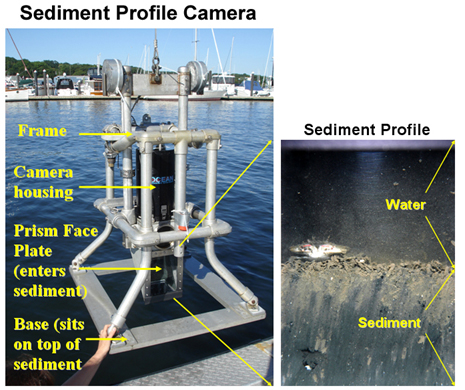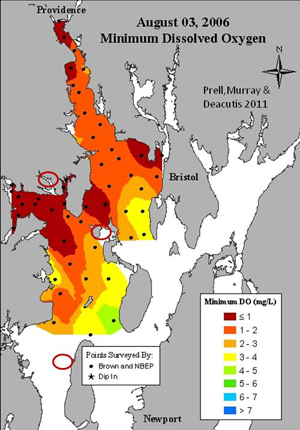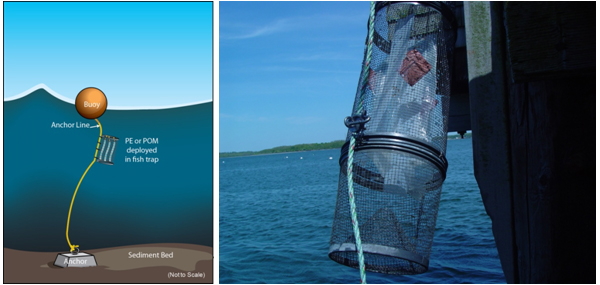Near-term approaches for sustainable solutions
AED is conducting highly focused research in important areas such as contaminated sites, nitrogen effects and wetland integrity to help communities develop sustainable solutions to environmental problems.

Project: Contaminated Sediments
Research task: Innovative physical, chemical, and biological tools are being developed to assess the effects and effectiveness of contaminated sediment remediation.
Tools and guidance are being developed to more accurately characterize the effects and effectiveness of Superfund contaminated sediment site clean-ups, thus reducing uncertainty. The focus is on providing more time- and cost-effective metrics for use in the decision-making process at these sites. Further, AED provides site-specific consultation on sediment remediation issues, including both short- and long-term monitoring plans and site assessment techniques.
AED Task Lead: Barbara Bergen
Research task: Development of passive sampling techniques for assessing the bioavailability, fluxes, and biotic uptake of contaminants in sediments as related to remediation activities
The Superfund program needs tools and methodologies for measuring and incorporating chemical bioavailability into site assessments, and to more effectively monitor remedial performance and ecosystem restoration. Newly evolving passive sampling techniques are an ideal tool for meeting both of these needs. This research task is leading to the development of passive sampling tools, methodologies and applications for use at the Superfund program’s contaminated sediment sites.
The objectives of this research include (1) evaluating the effectiveness of different types of passive samplers in the field for monitoring water column concentrations of several legacy and emerging contaminants, (2) comparing passive sampler uptake to organismal bioaccumulation, (3) assessing the release of contaminants from sediments into the water column, and (4) determining the effects of dam removal on contaminant concentrations in the water column and sediments.
AED Task Lead: Rob Burgess
Project: Sustainable Management of Nitrogen
Research task: Wetlands and Nitrogen in the Narragansett Bay Watershed

AED is conducting mesocosm greenhouse and field research to examine the effects of the combined stressors of nitrogen over-enrichment, climate change, and accelerated sea level rise on coastal wetland systems. Field sites are located in Narragansett Bay, RI and, for within region comparisons, in coastal wetlands of NY and MA. Innovative methods including use of computer-aided tomography and stable nitrogen isotopes are used to measure the responses of plants and soils to anthropogenic stressors in the marsh systems. The data that are measured in the field and greenhouse research will be used to build sustainability models that can address northeast coastal wetland response to increasing nitrogen loads and accelerated sea level rise in a changing climate.
AED Task Lead: Cathy Wigand
Research task: Lake ecosystem services in the northeastern United States
Degraded water and sediment quality in New England's lakes and ponds have resulted in the creation of noxious odors, poor aesthetic quality of the water and growth of occasionally toxic algae. Fish and wildlife habitats are negatively impacted as well. AED researchers are developing tools which can be used by decision-makers to make informed environmental restoration decisions.
AED Task Lead: Charlie Strobel

Research task: The effects of hypoxia on the provision of ecosystem services by marine benthic communities along the US Atlantic coast
Excessive inputs of nitrogen lead to eutrophication and hypoxia in coastal waters. Ecosystem services provided by benthic communities are impaired or lost as a result of hypoxia and anoxia in areas such as Narragansett Bay, Long Island Sound, Chesapeake Bay, and the "dead zone" in the Gulf of Mexico, leading to decreases in fish and shellfish production. This research addresses how key ecosystem services associated with estuaries are affected by changes in nitrogen loading and recycling and will provide estimates of hypoxia-caused reductions in ecosystem production functions from benthic communities.
AED Task Lead: Steve Hale
![[logo] US EPA](../gif/logo_epaseal.gif)
